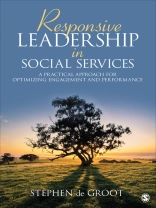Written for new and experienced social services managers and supervisors alike, Responsive Leadership in Social Services provides the practical tools, strategies, and insights to inspire, motivate, and engage employees and staff. Along with over 100 strategies and two simple tools—the Key Performance Motivators Scale (KPMS) and the Preferred Leadership Profile (PLP)—a wealth of practice wisdom, scholarship, and evidence-based research is presented to demonstrate the role of effective leadership and how it achieves positive client outcomes.
表中的内容
Acknowledgments
Preface
About the Author
PART I. A Case for Responsive Leadership
Chapter 1. Embracing Social Service Realities: Impediments to Preferred Practice and Quality Supervision
Social Service Workers: A Motivated and Committed Resource
Social Services: A Tough Work Environment
The Loss of Great Helpers: Implications for Employee and Client Outcomes
Supervision: A Possible Solution in a Crisis
Summary of Important Points
Personal Leader Reflections and Considerations
References
Chapter 2. Responsive Leadership: From Supervision to Inspiration
Leadership Defined
Quality and Effective Leadership: Key Ingredients
The Road to Responsive Leadership Approach
The Building Blocks of a Responsive Leadership Approach
The Guiding Priorities of Responsive Leadership
Summary of Important Points
Personal Leader Reflections and Considerations
PART II. From Concepts to Practice: Responsive Leadership Strategies and Tools
Chapter 3. Perception Is Everything
Perceptions of Effective Supervision and Quality Leadership
The Employee and the Employee’s Story
The Preferred Leadership Profile: Purpose
The Preferred Leadership Profile: Structure and Process
Ensuring Success: The Dos and Don’ts of the PLP
Summary of Important Points
Personal Leader Reflections and Considerations
References
Chapter 4. Meaning Making: Practical Strategies for Understanding and Accessing the Employee Story
Discovery and the Employee Story
Barriers to an Accurate Understanding of the Employee Story
Well-Intentioned and Unfortunate Pitfalls: Two Very Different Case Situations
The Importance of Relationships and Communication
Getting to Better by Accessing the Employee Story
Responsive Leadership: Priorities, Strategies, and Tools
Responsive Communication and Relations-Oriented Discovery
Discovery Responses and Discovery Questions
Making Meaning of the Challenge for Valerie
Important Comments on Meaning-Making Responses and Questions
Summary of Important Points
Personal Leader Reflections and Considerations
Chapter 5. A Strengths Focus and Quality Leadership
A Dire Need to Emphasize Strengths
Challenges to a Strengths Focus in Supervision and Management
A Problem Focus and Implications for Workers
Using a Strengths Approach to Enhance Quality Leadership
The Profound Implications of a Strengths Approach
Summary of Important Points
Personal Leader Reflections and Considerations
References
Chapter 6. Doing Quality Leadership: Practical Strategies for Inspiring
Relationship Domain
Vision and Values Domain
Mission and Goals Domain
Appreciative Domain
Personal and/or Professional Growth Domain
Feedback Domain
Strengths Domain
Summary of Important Points
Personal Leader Reflections and Considerations
Chapter 7. Understanding and Approaching Resistance and Opposition
What Are Resistance and Opposition?
Types of Resistance and Opposition
A Real Dilemma: Misunderstanding Employee Resistance and Opposition
Common and Problematic Beliefs About Resistance and Opposition
A Different Perspective: Resistance and Opposition as Information
Proactive Approaches for Minimizing and Even Eliminating Opposition and Resistance
Important Considerations for Supervisors to Avoid Resistance Altogether
Similar Behaviors, Different Meaning
Guiding Principles for Dealing Effectively With Resistance and Opposition
Revisiting Situation 2 From Chapter 4: Getting James Back on the Floor
Care-Fronting James: Approaching Resistance and Opposition, A Process Guide for Leaders
Summary of Important Points
Personal Leader Reflections and Considerations
Chapter 8. Epilogue
Where to Go From Here? Final Leadership Reflections and Considerations
Appendix A
Appendix B
Appendix C
Appendix D
关于作者
Stephen de Groot is a clinical and organizational consultant and author of the Relationship Based Strengths Approach (RBSA) (2003, 2013) for helping, the Empowering Social Workers Project (2006, 2010), and the Responsive Leadership Approach (2013) for Supervisors and Managers.As an associate professor and sessional instructor, de Groot has taught in both BSW and MSW programs for seven years with the faculty of social work at the University of Manitoba. Stephen has worked with more than 200 organizations within the human services and corporate sectors and has provided support, education, and learning development to professionals working in child welfare, mental health, child and youth care, youth homelessness, addictions, justice, education, and health.As an international trainer of more than 20, 000 participants, de Groot has made it his mission not only to inspire people but to empower and equip them with knowledge and tools so that they may also inspire and transform themselves and those for whom they are responsible.Stephen has occupied and continues to operate in a myriad of roles such as consultant, supervisor/manager, executive coach, trainer, author, and international speaker. Outside of his professional endeavors, Stephen continues to help others by devoting a great deal of his resources to giving and charity work. He is founder of the Getting to Better TM Initiative and chair of the advisory board of a global kindness movement known as Life Vest Inside TM. De Groot also promotes and supports the great work of two important nonprofit organizations: See Beautiful TM and VOICES, Manitoba’s Youth in Care Network.












